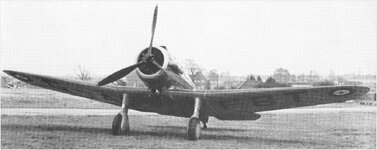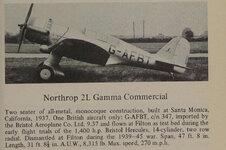Navigation
Install the app
How to install the app on iOS
Follow along with the video below to see how to install our site as a web app on your home screen.
Note: This feature may not be available in some browsers.
More options
You are using an out of date browser. It may not display this or other websites correctly.
You should upgrade or use an alternative browser.
You should upgrade or use an alternative browser.
Mystery Aircraft
- Thread starter gumbyk
- Start date
Ad: This forum contains affiliate links to products on Amazon and eBay. More information in Terms and rules
More options
Who Replied?Aichi didn't have the cockpit conopy moved back. Also the gunsight would be seen at the front of the windscreen. Additinally the shape of the wing is different from the Val. Her wing was of almost similar shape to the Spitfire wing with quite pointed wing tips. The one in the pic seems to have them more round.
*SkyChimp*
Airman
- 36
- Jan 7, 2018
It appears to have a side scoop air intake.

*SkyChimp*
Airman
- 36
- Jan 7, 2018
The radial engines side air intake and gear housing behing the prop suggests a Pratt and Whitney R-1340 S3H engine. The wing dihedral, pitot tube and canopy windscreen suggests a Northrop aircraft. The engine cowling is off from any Gamma. Japan got 2 civil Northrop Gammas, both went to the Navy. The markings on the fuselage do not appear to be windows, to me they appear to be asian letters. This could be a Japanese modified Northrop, or a Japnese copy (licensed or unlicensed), for their fledgling civil airlines.
GrauGeist
Generalfeldmarschall zur Luftschiff Abteilung
The Gamma series had a wide range of cowlings in relation to the model's engine being either a Wright or a Pratt & Whitney.
In the case of an air intake, if the model had one (few did), it was set back, behind the cowling. A clear example of this, would be the Gamma's USAAC derivative, the A-17.
The Gammas also had either an extreme setback to the cockpit or it was moved virtually to the firewall.
Not sure what to think about the "fledgling civil airlines" part, as the Japanese aviation industry was on a par with most other nations in the 20's and 30's.
The Gamma 2E, which also saw service with the Chinese Air Force also saw one each going to the British and Soviet Union for evaluation. Powered by a Wright R-1820-F53.
![Northrop_Gamma2E[800].jpg Northrop_Gamma2E[800].jpg](https://ww2aircraft.net/forum/attachments/northrop_gamma2e-800-jpg.494372/)
The single Gamma 5A built, was powered by a Wright R-1820-F52. In the photo, is the aircraft sold to the Imperial Japanese Navy in 1935, registered as BXN1. It was destroyed in an accident during testing.
![Northrop_Gamma5A[800].jpg Northrop_Gamma5A[800].jpg](https://ww2aircraft.net/forum/attachments/northrop_gamma5a-800-jpg.494373/)
The Gamma 5B was powered by a Pratt & Whitney R-1535-98 and only one airframe was built. After a brief tour of demonstrations in South America, it was sold to Spain in 1937, where it served with the Spanish Air Force flying coastal patrols.

The only Gamma 5D airframe made, was powered by a Pratt & Whitney R-1340-S3H1 and was initially intended for the Imperial Japanese Army, however the Imperial Japanese Navy took ownership of it in 1936 and gave it the code BXN2. The IJN conducted several tests and then transferred it to Nakajima, who found it useful in their development of the B5N. It was later turned over to the Manchurian Air Lines in the late 30's, who used it for reconnaissance in China and the Soviet Union.
![Northrop_Gamma5D[800].jpg Northrop_Gamma5D[800].jpg](https://ww2aircraft.net/forum/attachments/northrop_gamma5d-800-jpg.494375/)
None of the Gammas look close to the Mystery Ship..there are some similarities, which were common across the entire aircraft industry in the 1930's.
In the case of an air intake, if the model had one (few did), it was set back, behind the cowling. A clear example of this, would be the Gamma's USAAC derivative, the A-17.
The Gammas also had either an extreme setback to the cockpit or it was moved virtually to the firewall.
Not sure what to think about the "fledgling civil airlines" part, as the Japanese aviation industry was on a par with most other nations in the 20's and 30's.
The Gamma 2E, which also saw service with the Chinese Air Force also saw one each going to the British and Soviet Union for evaluation. Powered by a Wright R-1820-F53.
The single Gamma 5A built, was powered by a Wright R-1820-F52. In the photo, is the aircraft sold to the Imperial Japanese Navy in 1935, registered as BXN1. It was destroyed in an accident during testing.
The Gamma 5B was powered by a Pratt & Whitney R-1535-98 and only one airframe was built. After a brief tour of demonstrations in South America, it was sold to Spain in 1937, where it served with the Spanish Air Force flying coastal patrols.
The only Gamma 5D airframe made, was powered by a Pratt & Whitney R-1340-S3H1 and was initially intended for the Imperial Japanese Army, however the Imperial Japanese Navy took ownership of it in 1936 and gave it the code BXN2. The IJN conducted several tests and then transferred it to Nakajima, who found it useful in their development of the B5N. It was later turned over to the Manchurian Air Lines in the late 30's, who used it for reconnaissance in China and the Soviet Union.
None of the Gammas look close to the Mystery Ship..there are some similarities, which were common across the entire aircraft industry in the 1930's.
*SkyChimp*
Airman
- 36
- Jan 7, 2018
In the absence of any other explanation, a Japanese facsimile of a Northrop is as good as any. It certainly has elements more closely aligned to Northrop designs than any other make I've seen. I do not believe this plane has anything to do with the Spanish Civil War as proffered elsewhere. The background suggests otherwise. The engine appears to be a P&W. The prop cone is unlike any I've seen attached to any American plane of the time. It's deeply parabolic in shape. It has a distinctive Japanese flair to it. And, again, the markings on the side appear to be asian characters, quite possibly Japanese. Perhaps instead of comparing it to other aircraft, it would be wise to research Japanese air carriers of the 1930s. Which used that paint scheme? Which used script that could match what's on the side of this plane? Research into that may yuield results. I believe as good an explanation as any is that this is a Japanese plane, possibly a one off.
Nigel Brenton
Recruit
- 7
- Aug 30, 2018
GrauGeist
Generalfeldmarschall zur Luftschiff Abteilung
No enclosed cockpit and the maingear has a narrow track compared to the mystery ship.Looks like this one to me
maybeModified Northrop Gamma?
Attachments
SaparotRob
Unter Gemeine Geschwader Murmeltier XIII
Hey, Frufel, welcome to the Forum. Great pictures! This thread has been inactive for a few years but I'm glad you reopened it.
It's turned into an obsession for me, I thought surely it was one of the Japanese newspaper "goodwill flight" airplanes based on a translated article in a 1959 AAHS Jornal, but apparently not. The palm trees in the background really narrow down the options. One of those goodwill flights was to the Philippines but it definitely didn't involve this airplane. It has many features of Lockheed's Sirius/Altair aircraft but they all seem to be accounted for, and none had this particular style of landing gear or 3-blade prop. That AAHS article gives a tantalizing detail: "Following [a previous goodwill flight] the Mainichi Shimbun [newspaper] purchased a new type Lockheed Altair for a similar flight. This was to be to Manchuria... The old Altair had a Hamilton fixed-pitch metal propeller, but the new one had a controllable-pitch prop and the horsepower of the Pratt and Whitney Wasp was increased to 500-525 hp." Maybe tied in with a switch to 3-blade prop? No photos suggest it, though. This is just the kind of thing that I can't drop - hope somebody comes up with an answer soon, I've got other things I need to be working on!Hey, Frufel, welcome to the Forum. Great pictures! This thread has been inactive for a few years but I'm glad you reopened it.
Users who are viewing this thread
Total: 1 (members: 0, guests: 1)


